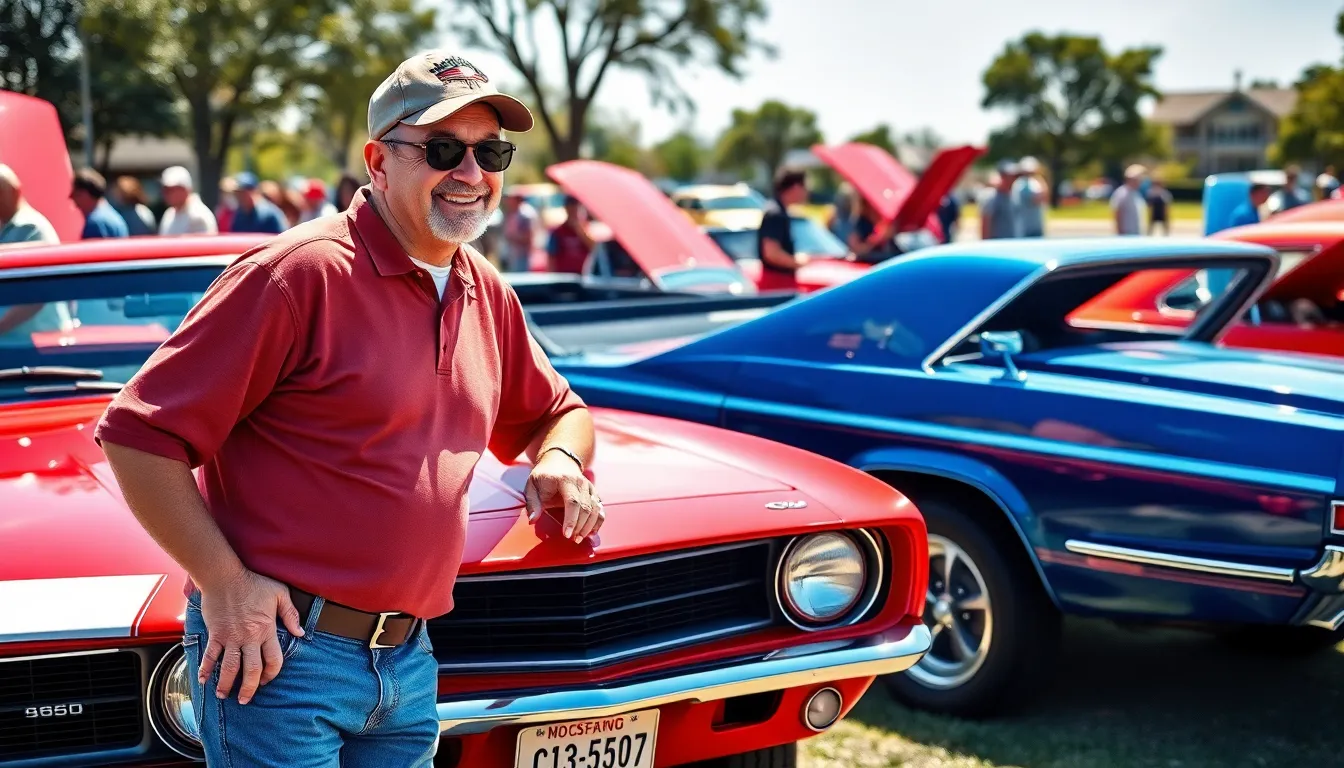We’ve all felt that unmistakable rush when spotting a gleaming ’69 Camaro or hearing the rumble of a vintage Mustang’s V8 engine. American classic cars aren’t just vehicles – they’re rolling pieces of history that capture our nation’s automotive golden age from the 1950s through the 1970s.
These iconic machines represent more than transportation; they embody the American dream itself. From Detroit’s legendary muscle cars to California’s sleek cruisers, classic American automobiles defined generations and continue to command respect on today’s roads. Whether it’s the raw power of a Dodge Charger R/T or the elegant lines of a Chevrolet Corvette, these automotive legends tell the story of American ingenuity and craftsmanship.
We’re diving deep into the industry of American classic cars to explore what makes these timeless beauties so captivating. From their historical significance to their lasting impact on car culture, we’ll uncover why these automotive treasures remain America’s most coveted collectibles.
Muscle Cars That Defined American Power
The muscle car era transformed American automotive culture with raw horsepower and bold designs that captured the nation’s spirit. These legendary machines continue to represent the pinnacle of American engineering excellence.
Ford Mustang: The Pony Car Revolution
Ford Mustang launched in 1964 and instantly revolutionized the automotive industry with its affordable sports car appeal. We witnessed history as this iconic vehicle sold over one million units within its first 18 months, creating an entirely new market segment known as pony cars.
Performance variants like the Shelby GT350 and Boss 429 delivered serious horsepower that could compete with any muscle car on the street. The 1965 Mustang featured engine options ranging from a 200 cubic inch inline six to a thundering 289 cubic inch V8 producing up to 271 horsepower.
Design elements including the distinctive triple taillights, aggressive front grille, and long hood short deck proportions became the template for American sports cars. We can trace the Mustang’s influence through generations of performance vehicles that followed its successful formula of style, power, and affordability.
Chevrolet Camaro: GM’s Answer to Ford
Chevrolet Camaro arrived in 1967 as General Motors’ direct response to the Mustang’s overwhelming success. We saw GM engineers create a platform that could accommodate everything from economical six cylinder engines to the legendary 427 cubic inch big block V8.
Track focused models like the Z/28 and SS variants established the Camaro as a serious performance contender with racing pedigree. The 1969 Camaro ZL1 packed an aluminum 427 engine producing over 430 horsepower, making it one of the most powerful production cars ever built.
Styling cues including the distinctive hideaway headlights, aggressive hood bulges, and muscular rear fender flares gave the Camaro its own unique identity. We continue to see these design themes influence modern Camaro generations, proving the timeless appeal of the original muscle car formula.
Dodge Challenger: Mopar’s Muscle Machine
Dodge Challenger entered the muscle car scene in 1970 with the largest engine bay in its class, accommodating Mopar’s most powerful motors. We witnessed Chrysler’s engineering team create a platform capable of handling the legendary 426 Hemi and 440 Six Pack engines.
Performance specifications included the R/T models that featured standard 383 cubic inch V8 engines, while the T/A variant used the Trans Am racing inspired 340 Six Pack setup. The 1970 Challenger R/T with the 426 Hemi could accelerate from zero to 60 mph in just 5.1 seconds.
Body proportions featuring the longest hood in the pony car segment, distinctive split grille design, and optional shaker hood scoop created an unmistakable presence. We recognize the Challenger’s influence on modern muscle car design, with Dodge successfully reviving the nameplate using many original styling elements.
Luxury Cruisers From the Golden Age
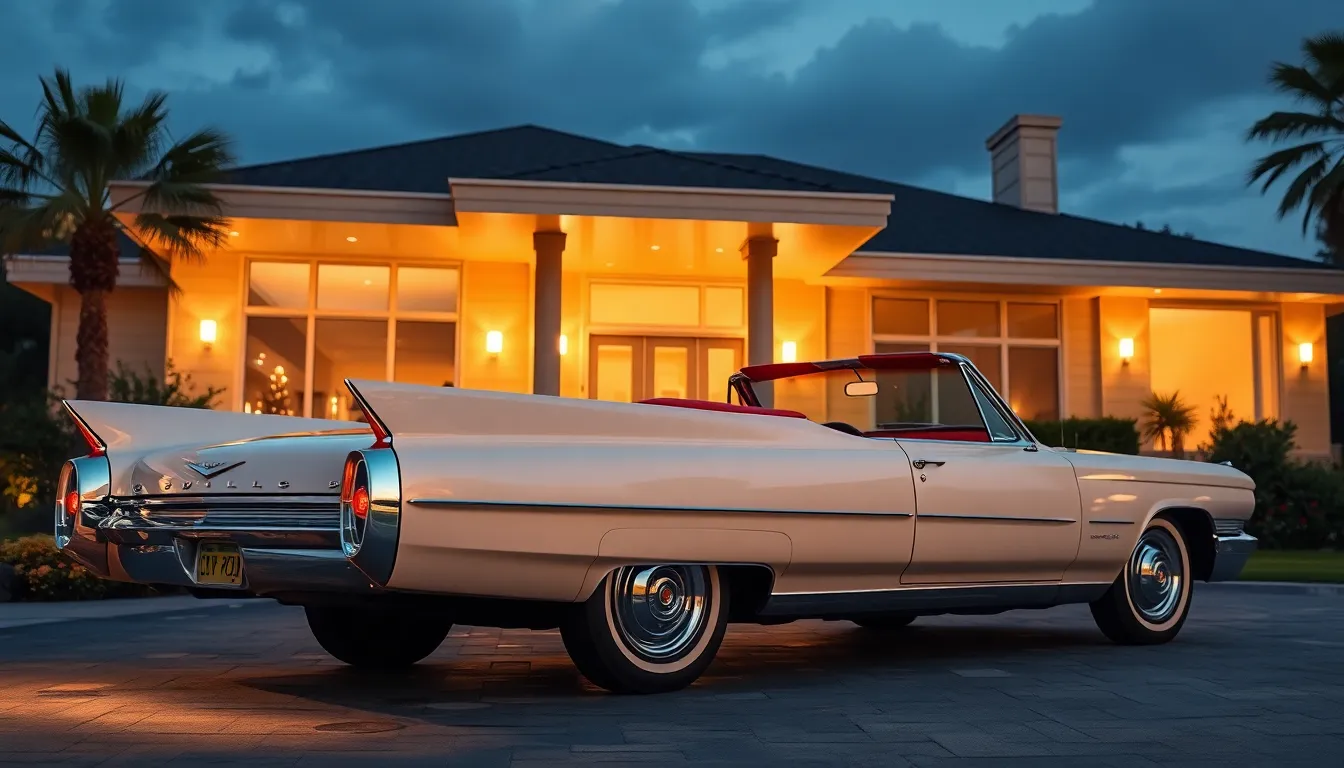
While muscle cars dominated the performance scene, American automakers crafted magnificent luxury vehicles that epitomized elegance and prestige. These opulent cruisers represented the pinnacle of automotive sophistication during the golden age.
Cadillac Eldorado: American Elegance Personified
Cadillac Eldorado stands as the ultimate expression of American luxury from 1953 to 2002. General Motors positioned this flagship model as the brand’s most prestigious offering, featuring cutting-edge technology and sumptuous appointments that defined automotive excellence.
First-generation Eldorados commanded premium prices, with the 1953 convertible selling for $7,750 when average cars cost under $2,000. Revolutionary features included power steering, power brakes, and automatic transmission as standard equipment across all trim levels.
Distinctive styling elements separated Eldorados from lesser Cadillacs through unique body panels, exclusive grille designs, and signature tail fin treatments. The 1959 Eldorado Biarritz showcased the era’s space-age aesthetics with towering fins and elaborate chrome detailing that measured over six feet in height.
Performance matched the luxury appointments with powerful V8 engines delivering smooth, effortless acceleration. The 1970 Eldorado introduced front-wheel drive to the American luxury segment, featuring a massive 500-cubic-inch engine producing 400 horsepower.
Lincoln Continental: Presidential Style and Comfort
Lincoln Continental earned its reputation as America’s premier luxury sedan through association with presidents and celebrities from 1939 to 2020. Ford’s luxury division created these vehicles to rival Cadillac while establishing a distinctly American alternative to European luxury cars.
Presidential connections elevated the Continental’s status when Franklin D. Roosevelt used a custom 1939 model for official duties. John F. Kennedy’s tragic assassination in a 1961 Lincoln Continental convertible forever linked the model to American history and presidential transport.
Fourth-generation Continentals from 1961 to 1969 represented the model’s design pinnacle with clean, understated styling that influenced luxury car aesthetics for decades. These vehicles featured suicide doors, spacious interiors, and meticulous build quality that justified their premium pricing.
Comfort features included standard air conditioning, power accessories, and premium leather upholstery in multiple color combinations. The Continental’s 430-cubic-inch V8 engine provided refined power delivery suitable for dignified transportation rather than aggressive performance.
Chrysler Imperial: The Crown Jewel of American Luxury
Chrysler Imperial competed directly with Cadillac and Lincoln as America’s third luxury nameplate from 1955 to 1993. Chrysler Corporation positioned the Imperial as a standalone brand rather than a trim level, emphasizing its premium status through unique styling and advanced engineering.
Engineering innovations distinguished Imperials from competitors through features like torsion bar front suspension, unibody construction, and advanced electrical systems. The 1957 Imperial introduced curved side glass and compound windshields years before other manufacturers adopted these technologies.
Styling excellence reached its peak with Virgil Exner’s Forward Look designs that featured soaring fins, distinctive grilles, and sculptural body lines. The 1961 Imperial showcased freestanding headlights and a formal roofline that conveyed dignified elegance rather than flashy ostentation.
Luxury appointments included standard power steering, power brakes, and automatic transmission across all Imperial models. Interior accommodations featured rich leather upholstery, genuine wood trim, and spacious seating for six passengers in supreme comfort.
Iconic Corvettes That Changed Sports Car History
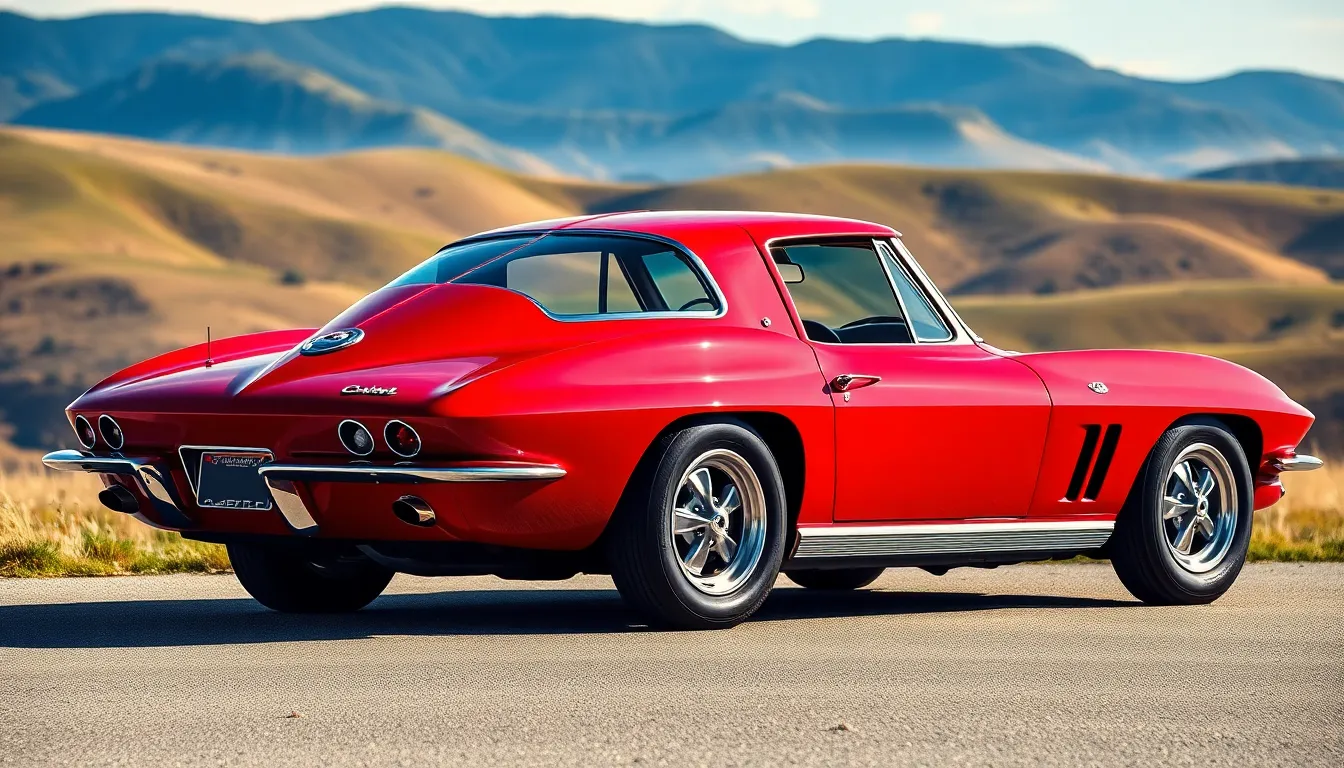
Building on America’s muscle car dominance, we explore the Chevrolet Corvette’s revolutionary impact on sports car design and performance standards.
1953 Fiberglass Pioneer: America’s First Sports Car
Chevrolet revolutionized American automotive manufacturing when it introduced the 1953 Corvette as the nation’s first production fiberglass sports car. Engineers at General Motors chose fiberglass construction to reduce weight and enable complex curves that steel couldn’t achieve cost-effectively.
Production numbers remained limited with only 300 hand-built units rolling off the assembly line in 1953, making these original Corvettes among the most valuable American classics today. Each vehicle featured a distinctive polo white exterior with red interior and a removable fiberglass hardtop.
Performance specifications included a 235-cubic-inch Blue Flame inline-six engine producing 150 horsepower, paired with a two-speed Powerglide automatic transmission. This combination delivered respectable acceleration for the era while establishing Corvette’s sports car credentials against European competitors like Jaguar and Ferrari.
Split-Window 1963: The Most Coveted Generation
Styling excellence reached its peak with the 1963 Corvette Sting Ray coupe, featuring the iconic split rear window that would never appear again in Corvette history. Designers created this distinctive element even though concerns about rear visibility, prioritizing aesthetic appeal over practicality.
Market reception proved extraordinary with 21,513 units sold in 1963, including 10,594 coupes and 10,919 convertibles. The split window coupe commands premium prices today, often selling for $150,000 to $300,000 depending on condition and options.
Engineering innovations included independent rear suspension, a first for American production cars, along with concealed headlights and side exhaust options. Power came from various small-block V8 engines, including the legendary fuel-injected 327 producing 360 horsepower.
1970s Stingray: Peak Performance Era
Power wars intensified during the early 1970s as Corvette engineers developed increasingly potent engine options to compete with muscle cars. The 1970 model year introduced the legendary LS5 454 big-block V8, producing 390 horsepower and establishing Corvette as a serious performance contender.
Performance achievements peaked with the 1970-1972 models featuring the optional LS6 454 engine, officially rated at 425 horsepower but likely producing closer to 500 horsepower in actual testing. Quarter-mile times dropped to the mid-13-second range, matching or exceeding contemporary muscle cars.
Design evolution continued with the distinctive “Coke bottle” shape that defined the C3 generation from 1968 to 1982. Chrome bumpers transitioned to body-colored urethane units by 1974, while flared fenders accommodated wider tires and enhanced the aggressive stance that collectors prize today.
Classic Pickup Trucks That Built America
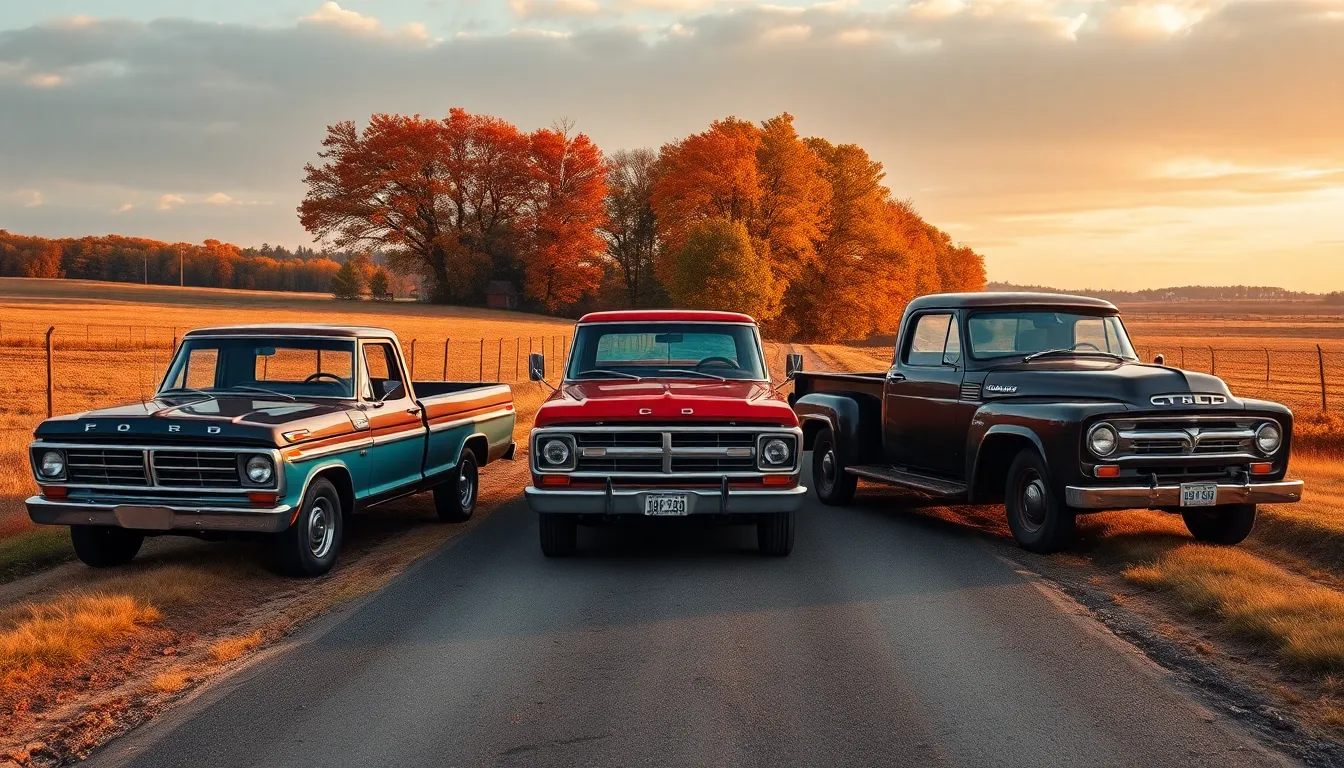
Moving beyond sports cars and luxury vehicles, we discover the backbone of American industry in classic pickup trucks. These hardworking machines shaped our nation’s infrastructure while capturing the essence of American determination.
Ford F-Series: The Workhorse Legacy
Ford F-Series trucks revolutionized commercial and personal transportation when they debuted in 1948. We witnessed the transformation of utilitarian work vehicles into America’s best-selling truck line for over seven decades. The 1953 F-100 featured Ford’s first overhead valve V8 engine, delivering 106 horsepower that outperformed most competitors.
Design innovations defined the F-Series evolution throughout the 1950s and 1960s. Ford introduced the distinctive cab forward design in 1957, maximizing cargo space while improving driver visibility. The 1961 F-100 Unibody eliminated the separate frame construction, creating a smoother ride that appealed to suburban buyers beyond traditional work sites.
Performance capabilities reached new heights with the 1965 F-100’s optional 352-cubic-inch V8 engine. This powerplant generated 208 horsepower, enabling the truck to handle heavy payloads while maintaining highway speeds. Racing enthusiasts embraced modified F-Series trucks, with many featuring custom suspension setups and engine modifications for drag strip competition.
Chevrolet C/K Series: Bow Tie Reliability
Chevrolet C/K Series trucks emerged in 1960 as GM’s answer to Ford’s growing market dominance. We recognize these trucks for their distinctive dual headlight design and independent front suspension that improved ride quality significantly. The C10 designation indicated two-wheel drive models, while K10 variants featured four-wheel drive capability.
Engineering excellence characterized the C/K Series throughout the 1960s and early 1970s. Chevrolet offered multiple engine options including the legendary 350 small-block V8, which produced 255 horsepower in its highest output configuration. The 1967 C10 introduced the iconic fleetside bed design that maximized cargo capacity while maintaining clean body lines.
Cultural impact extended far beyond construction sites and farms. Custom truck builders gravitated toward C10 models for their modification potential, creating lowriders with airbag suspensions and high-performance street machines. The 1972 C10 became particularly sought after for its refined styling and powerful engine combinations.
Dodge Power Wagon: Off-Road Capability Pioneer
Dodge Power Wagon trucks established the template for modern four-wheel-drive vehicles when production began in 1946. We credit these robust machines with introducing civilian buyers to military-grade off-road technology previously reserved for wartime applications. The original Power Wagon featured a 230-cubic-inch flathead six-cylinder engine producing 94 horsepower.
Military heritage defined every aspect of Power Wagon construction and capability. Dodge based the civilian version on their successful WDX military truck, incorporating a transfer case, front and rear differential locks, and heavy-duty suspension components. Ground clearance measured 9.5 inches, allowing the Power Wagon to traverse terrain that stopped conventional trucks completely.
Adventure seekers embraced Power Wagons for hunting expeditions, mining operations, and remote construction projects. The 1968 W200 Power Wagon received Dodge’s 318-cubic-inch V8 engine, increasing power output to 230 horsepower while maintaining the truck’s legendary durability. These capabilities established Dodge as the premier manufacturer of serious off-road pickup trucks for decades.
Convertible Dreams of the 1950s and 1960s

Open air motoring reached its pinnacle during these groundbreaking decades when American automakers perfected the art of convertible design. Wind in your hair became the ultimate expression of freedom and style.
Chevrolet Bel Air: Suburban American Style
Chevrolet’s Bel Air convertible captured the essence of 1950s optimism with its distinctive two tone paint schemes and chrome accents that gleamed in the California sun. We find ourselves drawn to the 1957 model’s iconic tailfins and wraparound windshield that defined an entire generation’s automotive dreams.
Performance came courtesy of the legendary 283 cubic inch V8 engine that produced up to 283 horsepower in fuel injected form. Families across America embraced these stylish convertibles for weekend drives to drive in theaters and beach vacations that created lasting memories.
Sales figures tell the story of America’s love affair with the Bel Air convertible:
| Year | Units Produced | Starting Price |
|---|---|---|
| 1955 | 41,292 | $2,305 |
| 1956 | 41,268 | $2,443 |
| 1957 | 47,562 | $2,511 |
Styling elements like the distinctive side spear and continental kit option transformed the Bel Air into a rolling work of art. Chrome bumpers stretched from corner to corner while whitewall tires completed the classic American look that influenced automotive design for decades to come.
Ford Thunderbird: Personal Luxury Redefined
Ford’s Thunderbird revolutionized the personal luxury convertible market when it debuted in 1955 as America’s answer to European sports cars like the Chevrolet Corvette. We consider the original two seater T Bird one of the most beautiful American cars ever produced.
Engineering excellence showed in the Thunderbird’s 292 cubic inch Y block V8 that delivered smooth power through a three speed automatic transmission. Porthole windows in the removable hardtop became signature design elements that distinguished Thunderbirds from every other convertible on the road.
Market reception exceeded Ford’s wildest expectations with over 16,000 units sold in the debut year alone. Celebrities from Marilyn Monroe to Frank Sinatra chose Thunderbirds as their preferred transportation method for Hollywood premieres and weekend getaways.
Interior appointments included power steering, power brakes, and optional air conditioning that made long distance cruising a pleasure rather than an endurance test. Wire wheels and continental spare tire mounting created an elegant profile that photographers captured in countless magazine spreads.
Pontiac GTO: The Original Muscle Drop Top
Pontiac’s GTO convertible launched the muscle car revolution in 1964 by stuffing a 389 cubic inch V8 into the lightweight Tempest platform. We credit this bold move with creating an entirely new automotive category that dominated American roads throughout the 1960s.
Power output ranged from 325 horsepower in standard form to an incredible 360 horsepower with the Tri Power carburetor setup that featured three two barrel units working in harmony. Quarter mile times dropped into the mid 14 second range when equipped with the four speed manual transmission and limited slip differential.
Production numbers reveal the GTO’s immediate impact on American car culture:
| Year | Convertible Production | Total GTO Production |
|---|---|---|
| 1964 | 6,644 | 32,450 |
| 1965 | 11,311 | 75,342 |
| 1966 | 12,798 | 96,946 |
Rally wheels, hood mounted tachometer, and dual exhaust outlets created the aggressive appearance that muscle car enthusiasts still seek today. Bucket seats with center console provided the sporting interior that matched the GTO’s high performance capabilities while maintaining comfort for daily driving duties.
Racing Legends Born on American Streets
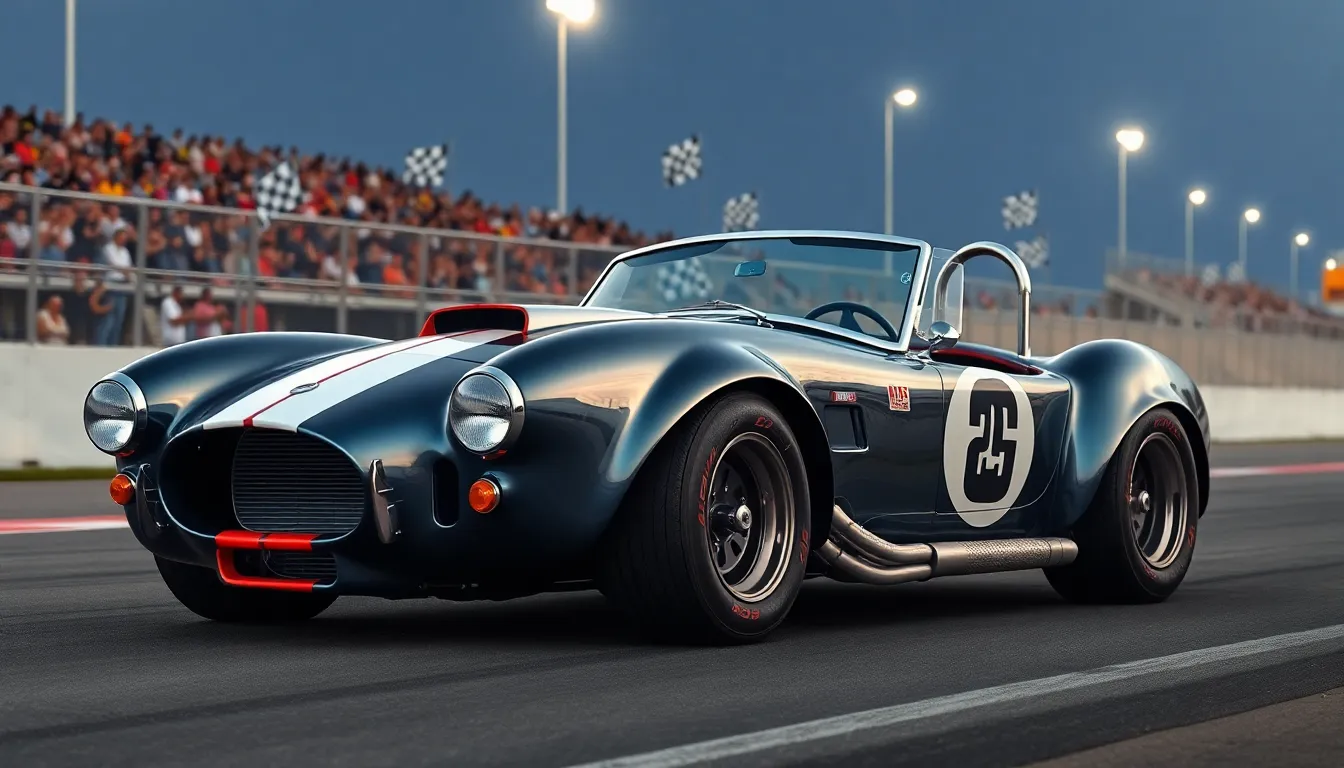
American classic cars didn’t just conquer highways—they dominated racetracks and drag strips across the nation. These performance machines evolved from street legal vehicles into legendary racing icons that continue to influence motorsports today.
Shelby Cobra: Ford Power Meets British Chassis
Carroll Shelby’s vision transformed the lightweight AC Ace into America’s most feared sports car when he dropped Ford’s 289 cubic inch V8 into the British roadster in 1962. We’ve witnessed how this combination created a power-to-weight ratio that humbled European supercars, with the original Cobra 289 weighing just 2,020 pounds while producing 271 horsepower.
Racing success came immediately when Dave MacDonald piloted a Cobra to victory at the 1963 Times Grand Prix at Riverside International Raceway. Ford’s decision to upgrade to the 427 cubic inch big block engine in 1965 created the ultimate street legal race car, generating 425 horsepower that could propel the Cobra from zero to 60 mph in just 4.2 seconds.
Competition victories mounted throughout the 1960s as Cobras dominated SCCA A-Production racing and earned international recognition at Le Mans and the Targa Florio. Today’s collectors pay premium prices for authentic Shelby Cobras, with original 427 models reaching auction values exceeding $1 million.
Plymouth ‘Cuda: Quarter-Mile Domination
Plymouth’s ‘Cuda emerged as the ultimate drag strip warrior when the company introduced the AAR ‘Cuda and 440 Six Pack models in 1970. We’ve seen how Chrysler’s commitment to straight-line performance resulted in quarter-mile times that embarrassed competitors, with the 440 Six Pack achieving consistent 13.5-second elapsed times at over 105 mph.
Mopar’s legendary 426 Hemi engine option transformed the ‘Cuda into a street legal funny car that terrorized drag strips nationwide. Racing teams embraced the ‘Cuda’s aerodynamic advantages and robust drivetrain, leading to countless victories in Super Stock and Modified Production classes throughout the early 1970s.
Factory involvement in drag racing reached its peak when Plymouth sponsored professional teams like Sox & Martin Racing, whose ‘Cuda consistently dominated NHRA competition. Original Hemi ‘Cudas now command astronomical prices at collector car auctions, with pristine examples selling for more than $500,000.
Chevrolet Chevelle SS: Track-Proven Performance
Chevrolet’s Chevelle SS established itself as the thinking person’s muscle car when it debuted in 1964 with a balanced combination of power and handling that excelled on road courses and drag strips. We’ve observed how GM’s intermediate platform provided the perfect foundation for serious racing applications, weighing 500 pounds less than full-size competitors while maintaining structural integrity.
Track success began immediately when Roger Penske’s Chevelle SS dominated Trans-Am racing in the late 1960s, proving that American muscle cars could corner as well as accelerate. Chevrolet’s LS6 454 cubic inch engine option in 1970 delivered 450 horsepower and 500 lb-ft of torque, making the Chevelle SS one of the most powerful production cars ever built.
Professional racing teams gravitated toward the Chevelle’s proven durability and parts availability, leading to victories in NHRA Super Stock competition and SCCA Trans-Am series. Modern classic car enthusiasts recognize the Chevelle SS as one of the most versatile performance cars of the muscle car era, with values continuing to appreciate among serious collectors.
Restoration Investment Opportunities

We’ve seen classic American cars evolve from nostalgic collectibles to serious investment vehicles that often outperform traditional financial markets. Today’s restoration projects can yield substantial returns when approached with strategic market knowledge.
Factors Affecting Classic Car Values
Production numbers represent the most critical factor in determining a classic car’s investment potential. Limited production models like the 1969 Camaro ZL1 with only 69 units produced command premium prices that continue climbing. Rare factory options such as the 426 Hemi engine or exact color combinations can double a vehicle’s market value.
Historical significance drives collector demand beyond simple rarity metrics. Cars with racing heritage, celebrity ownership, or cultural importance like the Ford Mustang Boss 429 maintain strong appreciation rates. Documentation proving provenance through original build sheets, dealer invoices, and maintenance records significantly impacts valuation.
Condition authenticity determines restoration investment success more than visual appeal alone. Matching numbers engines, original paint codes, and factory installed options create value premiums that restored cars without these elements cannot achieve. Professional appraisers look for unmodified chassis, intact VIN tags, and original component date codes.
Market timing influences classic car values through economic cycles and generational preferences. Baby boomers driving muscle car demand have created price peaks for 1960s and 1970s models. Younger collectors now favor 1980s performance cars, suggesting future investment opportunities in previously overlooked models.
Most Sought-After Models by Collectors
Chevrolet Corvette Sting Rays from 1963 to 1967 represent blue chip investments with consistent appreciation patterns. Split window coupes command the highest premiums, while convertible models offer more accessible entry points with strong growth potential. L88 and ZL1 variants reach auction prices exceeding $500,000 for concours condition examples.
Ford Mustang Boss models including the 1969 Boss 429 and 1970 Boss 302 deliver exceptional investment returns. These track focused variants combine rarity with racing pedigree that appeals to both collectors and driving enthusiasts. Documentation proving original engine installations becomes crucial for maximum valuations.
Plymouth ‘Cuda and Challenger models with Hemi engines represent the pinnacle of muscle car collecting. Convertible examples bring premium prices, while hardtop versions offer more attainable investment opportunities. Color combinations like In-Violet or Plum Crazy Purple add important value premiums.
Chevrolet Camaro Z/28s from the first generation deliver strong returns with increasing collector recognition. Trans Am racing heritage and distinctive graphics packages create emotional connections that drive market demand. Restored examples with proper documentation consistently outperform broader collector car indices.
Market Trends for American Classic Cars
Auction results show American muscle cars achieving record prices with consistent year over year growth. Barrett-Jackson and RM Sotheby’s report average increases of 8-12% annually for investment grade classics. Six figure sales have become common for previously mid tier models, indicating broad market strength.
Demographic shifts create both opportunities and challenges for classic car investors. Baby boomer collectors downsizing their collections increase supply of premium examples. Generation X collectors entering peak earning years drive demand for 1970s and 1980s performance cars previously considered modern classics.
Professional restoration costs now justify investment approaches due to skilled labor shortages and parts availability challenges. Quality restorations range from $75,000 to $150,000 for concours level work. These costs support higher valuations while creating barriers that limit supply of properly restored examples.
Digital platforms transform how collectors discover and purchase classic American cars. Online auctions expand buyer pools beyond regional markets, creating price discovery for rare models. Social media communities share restoration knowledge and market intelligence that helps investors make informed decisions about project selections.
Conclusion
American classic cars remain timeless treasures that continue to captivate enthusiasts worldwide. We’ve witnessed how these automotive legends transcend mere transportation to become cultural artifacts that define generations.
The enduring appeal of these classics lies in their ability to connect us with America’s most innovative automotive period. Whether you’re drawn to the thunderous power of muscle cars or the refined elegance of luxury cruisers each vehicle tells a unique story of American craftsmanship and ambition.
Today’s collectors and investors recognize that these machines represent more than nostalgic memories—they’re tangible pieces of history with proven appreciation potential. As digital platforms continue revolutionizing the classic car market we’re seeing unprecedented opportunities for both seasoned collectors and newcomers to participate in this passion-driven investment industry.
The legacy of American classic cars ensures they’ll remain coveted symbols of automotive excellence for generations to come.
Frequently Asked Questions
What defines an American classic car?
American classic cars are typically vehicles from the 1950s to 1970s automotive golden age that represent superior craftsmanship, innovative design, and cultural significance. These include muscle cars like the Camaro and Mustang, luxury cruisers like the Cadillac Eldorado, and iconic sports cars like the Corvette. They embody the American dream and showcase the era’s automotive ingenuity.
Which muscle cars are considered the most iconic?
The most iconic American muscle cars include the Ford Mustang (launched 1964), Chevrolet Camaro (1967), and Dodge Challenger (1970). Notable variants include the Shelby GT350, Boss 429 Mustang, 1969 Camaro ZL1, and Challenger with the 426 Hemi engine. These vehicles defined American automotive power with their raw horsepower and bold designs.
What made luxury cars special during the golden age?
Golden age luxury cars like the Cadillac Eldorado, Lincoln Continental, and Chrysler Imperial epitomized elegance and prestige through cutting-edge technology, distinctive styling, and superior comfort. The Continental was favored by presidents and celebrities, while the Eldorado featured innovative design elements. These vehicles represented the pinnacle of automotive sophistication and American luxury craftsmanship.
How did the Chevrolet Corvette revolutionize American sports cars?
The Corvette, introduced in 1953 as America’s first production fiberglass sports car, featured lightweight construction and impressive performance. The 1963 Sting Ray with its iconic split rear window and the 1970s models with powerful LS5 and LS6 V8 engines established new performance standards, solidifying the Corvette’s status in American sports car history.
What role did pickup trucks play in American automotive history?
Classic pickup trucks like the Ford F-Series, Chevrolet C/K Series, and Dodge Power Wagon built America’s infrastructure and embodied determination. The F-Series became America’s best-selling truck line since 1948, while the C/K Series introduced the iconic fleetside bed design. These trucks represented the backbone of American industry and adventure spirit.
Are classic American cars good investment opportunities?
Yes, classic American cars can be excellent investments when approached strategically. Factors like production numbers, historical significance, and authenticity affect values. Sought-after models include Corvette Sting Rays, Ford Mustang Boss variants, and Plymouth ‘Cudas. Market trends show consistent appreciation, with demographic shifts and digital platforms transforming the investment landscape.
What made convertible cars special in the 1950s-60s?
Convertibles like the Chevrolet Bel Air, Ford Thunderbird, and Pontiac GTO epitomized freedom and open-air motoring. The Bel Air symbolized 1950s optimism with its distinctive design, the Thunderbird redefined personal luxury, and the GTO launched the muscle car revolution in 1964. These vehicles reflected the era’s automotive dreams and cultural significance.
How did American classic cars perform in racing?
American classics like the Shelby Cobra, Plymouth ‘Cuda, and Chevrolet Chevelle SS became racing legends. The Cobra combined Ford power with lightweight British engineering for remarkable success. The ‘Cuda dominated drag strips with its 426 Hemi engine, while the Chevelle SS excelled on both road courses and drag strips, showcasing American automotive racing prowess.

